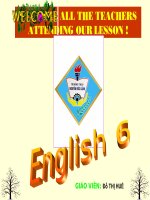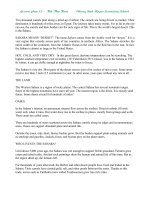presentation about Making food
Bạn đang xem bản rút gọn của tài liệu. Xem và tải ngay bản đầy đủ của tài liệu tại đây (3.91 MB, 57 trang )
Topic 2
The World of Plants
Standard Grade Biology
World of Plants is divided into:
A- Introducing plants
B- Growing plants (Pollination, Fertilisation,
Asexual reproduction)
C- Making food
Plants- the first link
Plants are the link between the energy in the sun
being converted into a form which animals can
eat and get the energy to survive…
Workbook Activity
p 54 Food webs and plants
The process by which plants do this is called:
Photosynthesis
All living things respire all the time to release
energy from their food in a process called:
Respiration
Plant survival
Plants make their own food, glucose, by
photosynthesis.
It only happens during the daytime when there is
light available.
This happens in plant cells containing the chemical
chlorophyll (green-coloured) which traps the light
energy.
The plants have captured light energy and turned it
into a store of chemical energy (glucose).
Raw materials Products
carbon dioxide + water glucose + oxygen
chlorophyll
More on the uses for glucose shortly…
Is light needed for photosynthesis?
1. Take a de-starched geranium plant (24h in dark).
2. Cover part of a leaf with some tin foil (this prevents
light getting through).
3. Leave the plant in sunlight for a few hours.
4. Test the leaf for starch.
Is carbon dioxide needed for
photosynthesis?
1. Take a de-starched
geranium plant
2. Enclose it in a plastic bag
with a chemical that
absorbs carbon dioxide.
(e.g. soda lime or sodium
hydroxide pellets).
3. Leave the plant in
sunlight for a couple of
hours.
4. Test the leaf for starch.
Questions:
1. Which parts of the leaf do you think will go blue-
black?
2. Why do parts that were not covered contain starch?
Is light needed for photosynthesis?
Workbook Problem
Solving
p 81 Making a starch print
Is carbon dioxide needed for
photosynthesis?
Questions:
1. Does the leaf contain starch? Why/ why not?
2. Has the plant carried out photosynthesis?
3. What would be your control plant’s conditions?
(Hint: a control plant should have everything it needs for
photosynthesis including carbon dioxide).
Workbook Problem
Solving
p 76 Plants and greenhouses
CO
2
is converted into glucose by photosynthesis.
Mans’ uses of plant glucose
Plants’ uses of plant glucose
Glucose
Used immediately to
provide energy source
for respiration
Energy used to
turn sugars,
nitrates & other
nutrients into
amino acids
which build up
proteins
To make cellulose, the
main structural
material in cell walls
Raw material for
growth, repair and
replacement of
damaged parts
Energy stored as
starch (in leaves,
seeds, roots and
tubers)
To make fats & oils
(energy stored in
seeds)
Energy stored as
sucrose (in fruit)
Glucose molecule
Workbook Activity
p 70 Changes in carbohydrate
Activity
– Testing a plant for sugar
1. Put a piece of raw onion in a pestle and mortar.
2. Grind it with a little sand and 10cm
3
of water.
3. Filter the liquid into a test tube
4. Heat the liquid with 10 drops Benedict’s solution in
a water bath
a) What colour change would you expect if sugar
was present?
b) Write an explanation of your results.
You need to know the plant experiments in detail,
explain the different steps, and results, in each one.
Activity
-Testing a leaf for starch
1. Dip a leaf into boiling water for
about a minute (to soften it).
2. Turn off the Bunsen burner.
3. Put the leaf into a test-tube of
ethanol (to remove chlorophyll).
4. Stand the test-tube in a beaker of
hot water for about 10 minutes.
5. Wash the leaf in cold water.
6. Spread the leaf out flat on a petri
dish and cover it with iodine
solution (tests for starch).
7. If the leaf goes blue-black,
starch is present.
Activity
-Testing a leaf for chlorophyll
Repeat the starch test
but this time use a
variegated leaf from a
geranium plant.
Variegated means that a
plant has coloured and
white parts on its leaves.
Do the green parts
contain chlorophyll? Do
the white bits? Which do
you think will test
positive for starch?
From little acorns do great
oaks grow…
Where do the extra
250kg come from?
Explain your
answer as fully and
scientifically as you
can.
A tree is planted in a meadow.
After 20 years it has grown into a big tree,
weighing 250kg more than when it was planted.
Gas Balance
During the day:
Oxygen released by photosynthesis is greater than
the amount of oxygen used up in respiration.
CO
2
used in photosynthesis is greater than the
amount of CO
2
produced by respiration.
glucose + oxygen carbon dioxide (CO
2
) + water
carbon dioxide + water glucose + oxygen
all the time
daylight only
Fill a jar with water.
Fill a test tube with water too
and cover the top as you
place it upside down inside
the jar.
Take a runner and feed it up
inside the test tube.
Leave in direct sunlight for a
few hours
Result?
A bubble of oxygen gas should
form at the top of the test tube as it
photosynthesises
Summary of Photosynthesis
Workbook Activity
p 64-65 Elodea bubbler expt
Plants’ waste product-
oxygen- is essential for
animal life.
Quick Quiz 1
1. What does a plant need for photosynthesis?
2. What does a leaf produce during photosynthesis?
3. What is chlorophyll?
4. How do the leaves obtain water?
5. How does the plant obtain carbon dioxide?
6. List 3 uses of the glucose produced by
photosynthesis?
7. Name the storage form of carbohydrate in a leaf.
Carbon dioxide, water, chlorophyll, light.
Oxygen, glucose
A green pigment which absorbs the sun’s energy
Through the roots (and xylem tubes by osmosis
From the air (through stomata)
Cellulose (structural), starch (storage), energy
Starch.
A leaf in time
Library activity
Source: />Read through the file and
take some short notes to
summarise the life of a leaf
/>alit_eng.pdf
Leaves…
Leaves are the
organs of
photosynthesis
and make all the
food for a plant.
We will look at:
Outer layers
(top & bottom)
Inner structure
including veins
(its transport
system)
Internal structure
Collect the handout ‘Leaf structure’ and add labels/notes.
mesophyll
waxy cuticle
Outer layer- upper surface
1. The waxy cuticle is a waterproof layer which cuts
down water loss by evaporation.
2. The upper cells of the leaf make up the epidermis.
They are transparent so light passes straight through
them into the next layer of cells…
1.waxy
2.
The palisade
layer contains
cells with lots of
chloroplasts.
The spongy layer (spongy
mesophyll) contains rounded cells
with many air spaces allowing CO
2
to circulate and reach the palisade
cells, while O
2
leaves.
Hence this is
where most
photosynthesis
occurs.
Chloroplasts
contain chlorophyll
which is the
chemical which
absorbs the sun’s
light energy.
mesophyll
Workbook Activities
p 66-67 Leaf surface and thickness
p67 Leaf layer cards- matching
Problem Solving
p78 How many stomata?
p79 Water content and dry weight.
p85 Use of cobalt choride paper
Bioviewers Box 79
The leaf of a flowering plant









